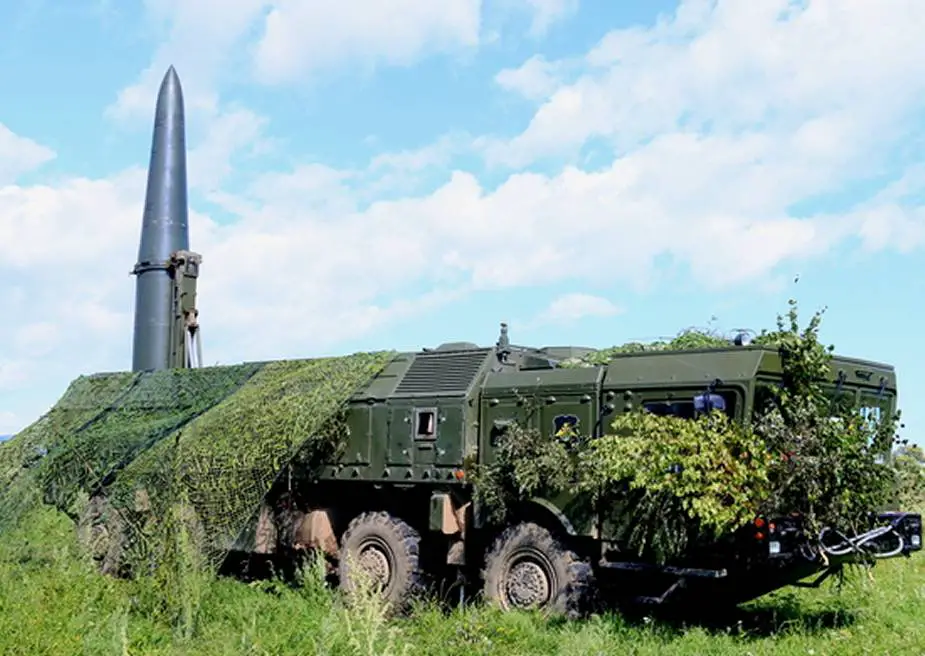Breaking news
Russian Iskander missiles handed over to Belarus for deployment close to Polish border.
Russia on April 4 said that it had handed over Iskander-M missile systems to Belarus. That announcement was made the same day as the official integration of Finland into NATO, thus not a coincidence. “The Iskander-M operational-tactical missile system was handed over to the Armed Forces of Belarus. It is capable of launching both conventional and nuclear missiles,” Russian Defense Minister Sergey Shoygu said during a conference call with the leadership of the country’s armed forces.
Follow Army Recognition on Google News at this link

Iskander-M complex during an exercise in Transbaikalia, June 2021 (Picture source: Wikipedia)
The training of Belarusian personnel on the use of the Iskander in Russia had begun the day before, according to some sources. And Russian President Vladimir Putin repeatedly announced that Russia will complete the construction of a special storage facility for tactical nuclear weapons in neighboring Belarus by forthcoming July, sparking fierce international criticism.
In late 2020, Russia deployed several Iskander-M ballistic missile systems to Belarus for military exercises. This deployment sparked concerns among neighboring countries and raised tensions in the region. Belarus is a close ally of Russia, and the two countries have a mutual defense agreement. Russian officials stated that the deployment of the Iskander missiles was part of routine military exercises and was not meant to threaten any other countries. However, neighboring countries such as Poland and Lithuania expressed concern over the deployment and called for increased NATO presence in the region.
The 9K720 Iskander (NATO reporting name: SS-26 Stone) is a mobile short-range ballistic missile system produced and deployed by the Russian military. They travel at a terminal hypersonic speed of 2,100–2,600 m/s (Mach 6–7) and can reach an altitude of 50 km as they range up to 500 km. The missile systems were intended to replace by 2020 the supposedly-obsolete OTR-21 Tochka systems in the Russian military.
The Iskander can carry different conventional warheads, including a cluster munitions warhead, a fuel–air explosive enhanced-blast warhead, a high-explosive fragmentation warhead, an earth penetrator for bunker busting and an electromagnetic pulse device for anti-radar missions. The missile can also carry nuclear warheads. In September 2017, the KB Mashinostroyeniya (KBM) general designer Valery M. Kashin said that there were at least seven types of missiles (and "perhaps more") for Iskander, including one cruise missile.
The Iskander ballistic missile is superior to its predecessor, the Oka. The Iskander-M system is equipped with two solid-propellant single-stage guided missiles, model 9M723K1. Each one is controlled throughout the entire flight path and fitted with an inseparable warhead. Each missile in the launch carrier vehicle can be independently targeted in a matter of seconds. The mobility of the Iskander launch platform makes a launch difficult to prevent.
Targets can be located not only by satellite and aircraft but also by a conventional intelligence center, by an artillery observer, or from aerial photos scanned into a computer. The missiles can be re-targeted during the flight in the case of engaging mobile targets. Another unique feature of Iskander-M is the optically guided warhead, which can also be controlled by encrypted radio transmission, including such as those from AWACS or UAV. The electro-optical guidance system provides a self-homing capability. The missile's onboard computer receives images of the target, then locks onto the target with its sight and descends towards it at supersonic speed.
Boost phase thrust vector control (TVC) is accomplished by graphite vanes similar in layout to the V-2 and Scud series tactical ballistic missiles. According to some rumors, in flight, the missile follows a quasi-ballistic path, performing evasive maneuvers in the terminal phase of flight and releasing decoys in order to penetrate missile defense systems (American officials have confirmed the use of decoys in at least some versions). The missile never leaves the atmosphere as it follows a relatively flat trajectory. The missile is controlled during the whole flight with gas-dynamic and aerodynamic control surfaces. It uses small fins to reduce its radar signature.
The Russian Iskander-M travels at a hypersonic speed of 2100–2600 m/s (Mach 6–7) and an altitude of 50 km. The Iskander-M weighs 4,615 kg, carries a warhead of 710–800 kg, has a range of 500 km and achieves a circular error probable (CEP) of 5–7 meters (when coupled with optical homing head; 30–70 m in autonomous application).
Iskander is a tactical missile system designed to be used in theater-level conflicts. It is intended to use conventional or thermonuclear weapon warheads for the engagement of small and area targets (both moving and stationary), such as hostile fire weapons, air and anti-missile defenses, command posts and communications nodes and troops in concentration areas, among others. According to Russian claims, the area of destruction from a single warhead is 25,000 square meters, or about two football fields and the accuracy of the missile allows it to hit targets the size of a small window from a range of several tens of kilometers.
In 2007, a new missile for the system (and launcher) was test-fired – the R-500 cruise missile – with a range of up to 2,000 km or more. When nuclear armed, the warhead is estimated to have a yield of 5 to 50 kilotonnes of TNT (21 to 209 TJ).
Defense News April 2023


























